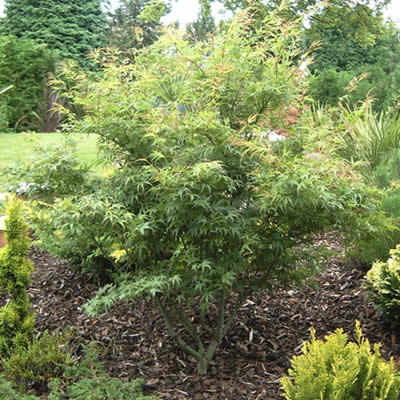Kamagata Japanese Maple |
|
|
Sapindaceae Acer Palmatum Kamagata |
|
| Price |
|
| Availability and Options |
Temporarily Out Of Stock This product is temporarily out of stock. Restocks typically occur at the beginning of each week. Check back soon and sorry for the inconvenience! |
| Shipping Information |
Cannot ship to: Alaska, California, Hawaii
|
| Grows In | Zone 5B · -15° to -10° F through Zone 9B · 25° to 30° F Grows in Columbus! (Learn More) |
| Sun Exposure | Morning Sun / Evening Shade, Dappled Light / Filtered Sun |
| Soil Drainage | Well Drained |
| Resistent To | Deer Resistant, Drought, Heat |
| Blooms | Fall Foliage, Spring Foliage |
| Foliage Color | Yellow, Red, Light Green |
| Average Height | 5' to 6', 4' to 5' |
| Average Width | 3' to 4' |
| Attracts | Visual Attention |
Acer Palmatum 'Kamagata' is a slow growing tree and perennial plant that can be grown in USDA Plant Hardiness Zones 5B through 9B. It matures to an average height of 5 feet to 5 feet and an average width of 3 feet to 4 feet, depending on climate and other environmental factors. It prefers growing in a location that provides morning sun with afternoon shade or filtered sun and grows best when planted in loam, clay or silt soil that is well drained. The foliage is yellow, red and light green in color. It attracts visual attention and is resistant to deer, drought and heat.
Kamagata Japanese Maple can be useful in the landscape in foundation plantings, in containers or planters, around decks, swimming pools, and other outdoor living areas, under a shade tree, as a focal point, to add property value, to accentuate entryways or in small groupings and also in rock or xeriscape gardens, theme gardens or shade gardens.
Gardener Direct offers over 150 outstanding and unique varieties of Japanese Maple. We are testing and adding new varieties every year. Our container-grown maples are expertly grown from grafts with the utmost care. Before we offer them for sale, plants are fully rooted and well-branched in 2, 3 or 5 gallon containers.
To determine hardiness and overall performance in the landscape, each variety of Japanese Maple has been field-tested in our trial gardens here in mid-Georgia. This means you can count on the specific information we provide about each plant.
 More about Kamagata Japanese Maple...
More about Kamagata Japanese Maple...'Kamagata' is a drought-tolerant upright dwarf (6-12 feet tall) that easy to grow and can thrive in dryer soils. It's the ideal selection for courtyard plantings, containers and rock gardens. It's trademark green leaves hang delicately from a dense array of branches creating a drooping effect. The small green leaves emerge in spring decorated with red margins. Summer leaves are light green changing to yellow-orange with a touch of red in fall. Named and propagated by J.D. Vertrees, 'Kamagata' is a unique culitvar that will surely add prestige and character to your garden.
Japanese maples stand out best when they are planted as a single specimen or in small groupings. Use them to accentuate an entryway or as a focal point to draw attention to a certain area of the landscape or home. Be careful not too overcrowd your Japanese Maple. We suggest underplanting with dwarf, low growing shrubs or groundcovers.
When provided the right environment in the landscape Japanese Maples are very easy to grow and care for, and long lived.
Soil - Japanese maples adapt well to many soil types provided there is good drainage. Consistently wet or soggy soils can be a killer.
Sun - Some varieties will tolerate full sun. However, in their natural habitat, Japanese Maples are understory trees, growing in dappled forest sunlight and at the edges of partially shaded woodlands. Ideally they prefer to be grown in similar conditions, especially in the warmer climate of the Deep South.
Pruning - When a specific variety of Japanese maple is planted in the right size space; where it have room to grow to mature size, rarely will it require pruning. That beings said, removal of damaged or stray branches that spoil the form of the tree can be performed almost any time of year. Heavy or major pruning is best left to professionals. If you hire someone to prune your Japanese maple make sure he/she has the credentials and ALWAYS check references.
Water - During the first two summers after planting a Japanese Maple, make sure to water enough to keep soil damp but not soggy. Constantly wet feet can cause serious problems. Proper planting method can ensure proper drainage over the long term.
SEE: Detailed Planting Instructions For How To Plant A Japanese Maple in the Ground